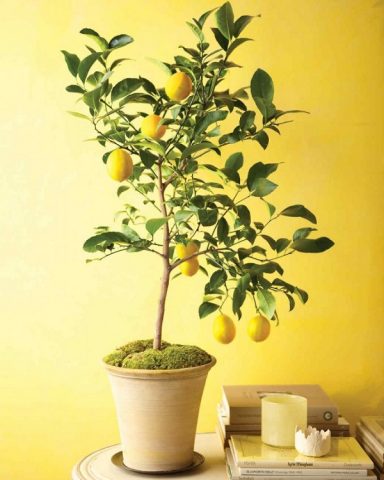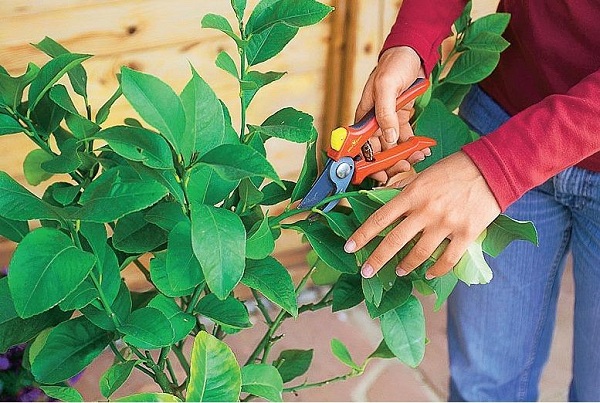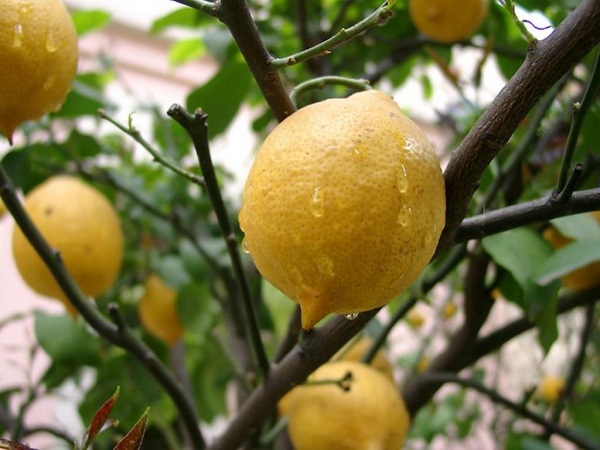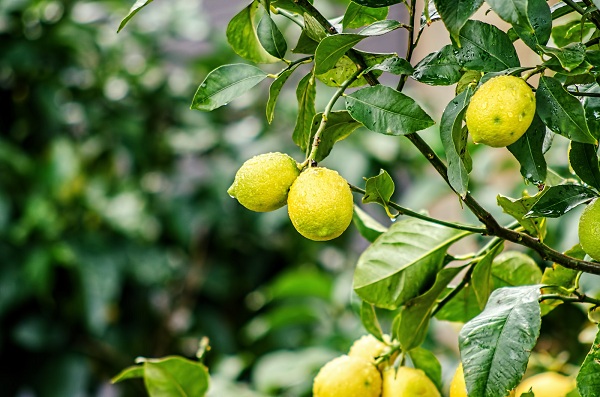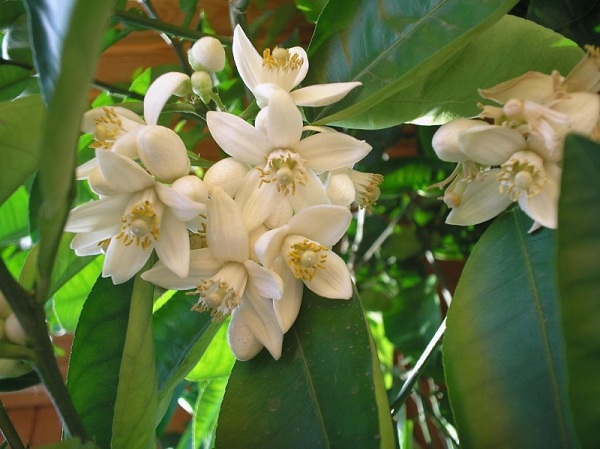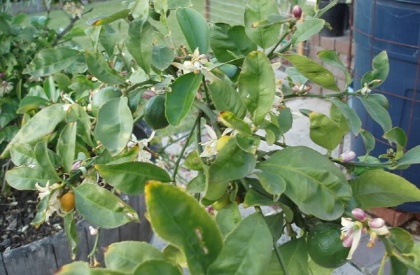Content
Care for a lemon or decorative tree must be done carefully. Citrus indoor trees are demanding on the microclimate, soil and environment. Back in the 12th century, the inhabitants of India began to grow lemons at home and use them in medicine, home life, and eat them. Bright yellow fruits with a delicate aroma make the home more cozy and comfortable.
How to properly care for a lemon tree
Growing citrus trees is quite troublesome, but citrus is particularly unpretentious. A young plant is purchased in gardening stores or they are trying to grow a tree from a seed, a rooted cuttings. If a seed has been planted, then the first fruits will appear in 7-8 years, and the purchased tree will begin to bear fruit in 3-4 years. Initially grown lemon at home will rarely hurt, bear fruit abundantly for a long time. For the entire period of its life, the plant can grow up to 1-1.5 m.
In the early stages of growth, you need to form a crown, cut off the upper branches, which contributes to the formation of new foliage. The plant will feel comfortable in a well-lit room with natural light. It is highly discouraged to move the tree, raise it sharply, place it or carry it. This leads to rapid shedding of foliage or buds. With abundant flowering, you need to remove empty flowers that do not have stamens. Also, too much fruit will drain the tree. On a fruiting branch, from 10 to 15 adult leaves are allowed, which feed the fruits until ripening.
An ornamental lemon tree in a pot is not placed on the floor because the roots of the plant are temperature sensitive. The pot is placed at the level of the window sill or so that at least 2 m remains to the ceiling. Caring for tinted citrus differs from the fruiting one in that pruning can be omitted. The tree reaches 60-70 cm and stops growing, then begins to bear fruit like a regular lemon. The fruits differ in size, taste and thickness of the skin. They can be overexposed on the branches, and the skin will not become thick. After full ripening, the fruits either fall off on their own, or they are cut off. Caring for an ordinary fruiting citrus tree is more meticulous.
Creation of optimal conditions
Creation of comfortable conditions and proper care of the lemon guarantee tasty and juicy fruits, as well as a healthy plant. The tree is very fond of warmth and light, so lemon is grown on stands in a room with a lot of light or on windowsills on the south side of the apartment.In diffused light, the tree will develop rapidly, but in the summer, the sun's rays are dangerous for the plant, so you need to limit the time citrus stays in the light to 3-4 hours. In winter, the plant needs more light, so the room should be regularly illuminated for up to 10-12 hours.
During growing and caring for lemon at home, you need to observe the temperature regime, maintaining a constant microclimate in the room from + 15 ° C to + 25 ° C. When the plant begins to bloom, the room is ventilated, the temperature is allowed to drop to + 10 ° C. A sharp change in climate must not be allowed, otherwise the foliage will crumble. After winter or summer airing, the tree is left in a cool place for 20-30 minutes to acclimatize the lemon. In winter, the tree is grown in the coolest and brightest room, providing maximum non-interference in the flowering process.
At temperatures from + 7 ° C and below, the plant hibernates and can independently suspend the growing season. With the onset of spring, the tree is taken out into the street at temperatures from + 12 ° C to + 15 ° C, when the ground completely begins to warm up, fumes are released. At this time, lemon can only be watered once a day. The tree is placed in shade or partial shade so that the process of getting used to sunlight is favorable. Citrus is brought into the room with the first signs of a drop in temperature. With the onset of autumn, a decorative tree is grown on the veranda until the first cold weather, then transferred to a cool room.
The air in the room should be regularly humidified 1-2 times a day using a spray bottle. The optimum humidity is up to 60-70%. In addition to air, you need to spray the leaves of the tree with water, it is allowed to wipe all the foliage with plain water. If any stains or pests appear, wipe each leaf with a damp soapy cloth. The solution must be very weak so as not to harm the plant, but only to disinfect it.
How to cut a lemon
Gardeners and gardeners disagree about when citrus pruning or crown shaping should be done. Caring for a lemon tree at home through pruning guarantees rapid crown development and an accelerated fruiting process. Pruning of the tree is done in the spring before the buds appear, in the fall - before the first rains and in winter during hibernation so that the tree will bear fruit well for the next season. The first formation of a purchased plant is done in the first year of life with home care, when the main trunk grows by 25-30 cm. The top of the stem is pinched or cut off so that the plant begins to branch.
Before the beginning of spring, in the second year of development, the lemon is re-pruned by 10-15 cm so that 5-6 shoots remain on the trunk, which will branch in different directions. There are cases when one or more buds grow from the main shoot, in the first case, 1 bud is cut off, in the second, the strongest shoot is left, removing the rest. All old annual shoots are removed under the base. The formation of the crown of a decorative lemon is accelerated by pruning young growing branches. A young plant can be placed on a windowsill. You can take care of the lemon before the first flowering by organizing regular watering, timely feeding and pruning.
The main formative pruning is carried out in the spring in March or April. Shoots that thicken the crown must be removed or pinched at the top of the shoot by 15-20 cm, then the branch will bear fruit. Sanitary pruning is done every season. Such care will prevent the lemon from getting sick or withering. Dry, diseased, weak branches are cut to healthy shoot tissue. Rejuvenating care and tree shaping are done after 5-10 years of lemon growth. As soon as the above zero temperature does not change much, all the lower branches are cut off from the lemon, the top is cut to fit the selected shape.Before trimming, tools are disinfected with alcohol, boiling water or diluted manganese solution.
The care and fruiting of lemon at home can be regulated even before flowering by pruning shoots and peduncles. In winter, up to 10-12 strong flowers are left on the tree. It is better to leave up to 7 peduncles on a young tree, then increase the number of ovaries left every year.
How to feed lemon
During leaving, it is useful to feed citrus with saltpeter at any time of the year. It relieves colored or regular lemon from nitrogen starvation. For 10 liters of water there are 40-50 g of nitrate, sometimes potash fertilizer is added. Mineral dressing is done with the onset of the first cold weather and in the middle of flowering. Superphosphates replace the lack of phosphorus in the soil and dissolve for a long time, so they are introduced into the soil 2 times a year. In order for the phosphates to act quickly, the raw materials are boiled until completely dissolved, then diluted in 10 liters of water. Let the solution cool. Then the lemon is watered 2 times a day.
Organic fertilizers for lemon are mullein and chicken droppings. Wood ash can replace mineral fertilizers. 500 g of dry raw materials are poured into 10 liters of water, left for 2 weeks for fermentation. Before each watering, 500 ml of the mixture is diluted with water and watered with citrus. Top dressing is applied during watering or sprayed with a solution from a spray bottle.
Lemon is looked after and fed:
- During the period of initial growth. Every 2 weeks, the plant is fed with nitrogen fertilizer or a small amount of nitrate.
- At the time of flowering. Potash, phosphorus or organic additives are added to the soil.
- During fruiting. Citrus is fed with organics and minerals alternately.
- During hibernation. The plant is fed with mineral supplements 1 time per winter season, the dosage is reduced by 2 times.
The ground should always be moist. Overdried soil during feeding with liquid solutions will stop the development of the plant, and it will die. In the fall, before hibernation, lemon is often poured with strong tea without additives.
Features of caring for indoor lemon in some cases
Indoor, ornamental and purchased wood requires all sorts of care. If the homemade lemon cannot be severely injured, and the decorative one needs to be cut often, then the purchased one is unpretentious in all phases of growth.
How to properly care for a lemon after a store purchase
It is recommended to buy citrus in gardening shops in the spring or summer season, when the temperature is always above zero, then the lemon tree quickly acclimatizes at home. Home care involves careful control of soil moisture and microclimate. Do not allow the soil to dry out; watering is carried out 1-2 times a day. Pruning is carried out at the beginning of autumn and in the middle of spring. Top dressing is done every month, alternating mineral and organic supplements.
How to care for potted lemon in winter
Winter care for indoor lemon in a pot affects the subsequent fruiting of the plant. The room temperature should not rise above + 7-10 ° С. Water the plant once a day with water at room temperature. Mineral supplements are combined with watering once a week. During the winter care period, there should be no active manifestation of growth, otherwise pruning is carried out. You need to provide constant lighting or expose citrus in the sun from dawn to sunset.
How to care for homemade lemon during flowering
During the flowering period, care for the lemon should be carried out so that the plant does not drop flowers or foliage due to anxiety. On a branch with a large number of flowers, 2-3 pieces are left.Young trees should not be allowed to bloom, only after the crown is fully developed, a small number of flowers are left. From improper care during the flowering period, leaves can become rusty. Watering is carried out every day. The duration of daylight hours for a lemon should last from 8 to 10 hours. Top dressing is done with bird droppings or a diluted solution of manure and water.
How to care for lemon at home during fruiting
During the fruiting period, it is better not to touch the lemon at all and take care of it carefully. If rearranged carelessly, the plant can shed its fruits. During care, you need to maintain a constant microclimate or ensure a regular temperature in the room. Optimal environment for good fruit development: + 20 ° C. Every month during the fruiting period, the soil is fertilized with organic additives. If the plant is young, then the lemon is fed every 3 months before the first flowering. To obtain a large and juicy harvest, ordinary water is replaced with an infusion of eggshells, which is watered to the plant once a week.
How to care for a potted lemon tree after fruiting
The fruits are cut as they ripen, along with the stalk. The egg solution is again replaced with plain water. Water the plant in the morning 1 time per day. The light regime must be extended up to 10 hours, and the plant must be brought out into the light. Some gardeners immediately prune and switch to winter care. After fruiting, the plant rests, so the roots are fed once a week with an organic or mineral complex of additives.
Features of caring for decorative lemon
Due to the hybridity of varieties, decorative lemons develop rapidly in growth, therefore, there are some peculiarities in caring for the plant. After 3-4 months of cultivation, the first pruning is carried out, then it is carried out every season. Such care will ensure a high-quality harvest; citrus will rarely get sick.
Watering is carried out every day, the light regime should not last more than 10 hours. The temperature in the room should not exceed + 18 ° С, otherwise the soil will dry out quickly. Regular care of the lemon, when it blooms, is suspended, during this period the plant should be at rest. Ornamental citrus is sprayed daily with a spray bottle. The tree tolerates movement and transplantation well. Over the entire life span, the lemon is transplanted 2-3 times and rejuvenating pruning is carried out every spring.
How to care for a lemon tree in an emergency
Emergencies include dry soil, disease or sudden plant reactions to the environment. Lemon, which needs frequent watering, folds the foliage into tubules, sheds it, or the leaves begin to turn yellow and rusty. From an overabundance of watering, the tree can sharply throw off the foliage, then it is better not to water the plant for 2-3 days, then reduce the frequency of watering.
It so happens that the citrus freezes. Care for a frozen lemon tree is carried out gradually and carefully. You can revive the plant by insulating the trunk with gauze, which is folded into 3-4 layers. Daylight hours for a frozen plant are extended to 15-18 hours. The temperature in the room should be from + 15 ° C to + 18. Frozen lower branches are completely pruned. The lemon re-acclimates after new buds appear.
Conclusion
Taking care of lemon is not as difficult as it seems. Gradually, the care process will become a habit, and the plant will delight the owner with a neat look and nutritious fruits. If you follow all the recommendations for caring for a lemon tree, you can not expect a sudden negative reaction to the microclimate or diseases.
